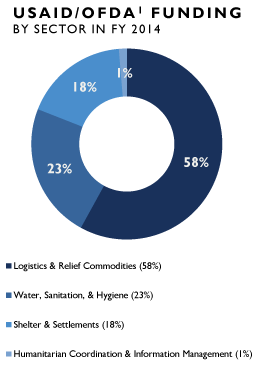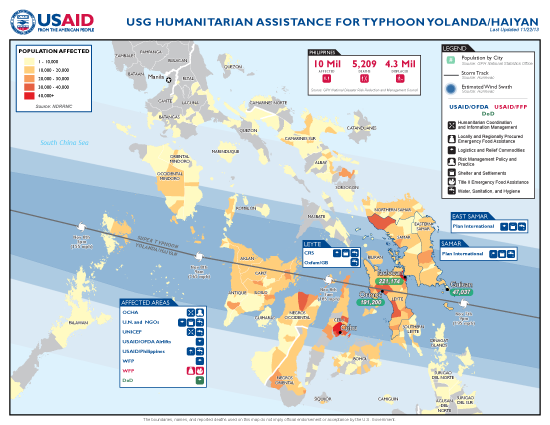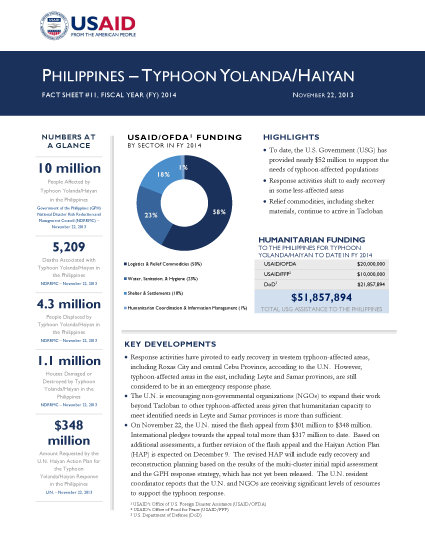- What We Do
- Agriculture and Food Security
- Democracy, Human Rights and Governance
- Economic Growth and Trade
- Education
- Ending Extreme Poverty
- Environment and Global Climate Change
- Gender Equality and Women's Empowerment
- Global Health
- Water and Sanitation
- Working in Crises and Conflict
- Disaster Assistance
- Political Transition Initiatives
- Conflict Mitigation and Prevention
- Countering Violent Extremism
- Disaster Risk Reduction
- Peacebuilding and Reconciliation
- Providing Safe & Secure Environments for Development
- Recovering From Crisis
- Resilience
- Tech Challenge for Atrocity Prevention
- World Humanitarian Day
- U.S. Global Development Lab
November 22, 2013
Numbers At A Glance
10 million
5,209
4.3 million
1.1 million
$348 million
Humanitarian Funding:
To The Philippines For Typhoon Haiyan/Yolanda To Date In FY2014:

| USAID/OFDA | $20,000,000 |
| USAID/FFP | $10,000,000 |
| DoD | $21,857,894 |
| TOTAL | $51,857,894 |
Typhoon Haiyan / Yolanda Fact Sheet #11 - 11/22/2013 ![]() (pdf - 215k)
(pdf - 215k)
Highlights
To date, the U.S. Government (USG) has provided nearly $52 million to support the needs of typhoon-affected populations
Response activities shift to early recovery in some less-affected areas
Relief commodities, including shelter materials, continue to arrive in Tacloban
Key Developments
Response activities have pivoted to early recovery in western typhoon-affected areas, including Roxas City and central Cebu Province, according to the U.N. However, typhoon-affected areas in the east, including Leyte and Samar provinces, are still considered to be in an emergency response phase.
The U.N. is encouraging non-governmental organizations (NGOs) to expand their work beyond Tacloban to other typhoon-affected areas given that humanitarian capacity to meet identified needs in Leyte and Samar provinces is more than sufficient.
On November 22, the U.N. raised the flash appeal from $301 million to $348 million. International pledges towards the appeal total more than $317 million to date. Based on additional assessments, a further revision of the flash appeal and the Haiyan Action Plan (HAP) is expected on December 9. The revised HAP will include early recovery and reconstruction planning based on the results of the multi-cluster initial rapid assessment and the GPH response strategy, which has not yet been released. The U.N. resident coordinator reports that the U.N. and NGOs are receiving significant levels of resources to support the typhoon response.
LOGISTICS AND RELIEF COMMODITIES
- Civilian logistics capabilities continue to improve dramatically, and humanitarian operations are extending to all barangays—the smallest administrative unit in the Philippines—in Tacloban. Despite developments, limited available landing space at the Tacloban airport continues to constrain air logistics capacity, according to the U.N. Meanwhile, a commercial operator is managing the Tacloban port at the request of the GPH. The Logistics Cluster—the coordinating body for logistics activities in the Philippines—reports that heavy lifting equipment, including forklifts and trailers, have arrived on-site.
- The U.N. World Food Program (WFP) chartered a ship capable of transporting up to 2,400 metric tons of cargo for an initial period of one month to transport relief commodities between Cebu and Tacloban, according to the Logistics Cluster.
- Between November 20 and 22, DoD delivered 18 WFP mobile storage units to Tacloban. The storage units will increase warehousing space for humanitarian commodities in Tacloban, facilitating the delivery of relief items to populations in need.
- On November 22, two DoD amphibious ships arrived in the Philippines as part of a transition from air to ship-to-shore logistics capabilities. The amphibious ships have ship-to-shore mobility and the capacity to move large amounts of cargo and equipment. The ships have a combined total of 900 Marines, elements of the 31st Marine Expeditionary Unit based in Okinawa, Japan.
- On November 22, the U.N. Humanitarian Air Service (UNHAS) distributed a flight schedule and reservation information to humanitarian organizations for round-trip flights to Cebu, Guiuan, Manila, Roxas, and Tacloban. UNHAS flights will enable relief organizations to better access affected areas.
- On November 21, a USAID Disaster Assistance Response Team (DART) logistics officer traveled to Tacloban to coordinate ongoing cargo operations. All USAID/OFDA-procured relief commodities, such as water containers, hygiene kits, and plastic sheeting, are expected to arrive in Tacloban by November 24.
PROTECTION
- The Protection Cluster—the coordinating body for protection-related humanitarian activities in the Philippines—has expressed concern about safety and dignity considerations for those living in shelters, adequate attention to persons with special needs, and the need for profiling and registration of unaccompanied children, missing persons, and internally displaced persons (IDPs)—particularly those who have evacuated to Manila and other areas. Gender-based violence (GBV) and protection specialists are working within the humanitarian community to obtain key gender-related data and integrate protection-focused activities throughout the response.
- An estimated 1.8 million children are displaced as of November 21, leaving many exposed to additional health and safety concerns, such as abuse and trafficking, according to the U.N. Children’s Fund (UNICEF). As reports of missing and unaccompanied minors continue to emerge, the need for family tracing and reunification increases.
- Protection Cluster partners have established registration hubs at transit points, such as Tacloban, Guiuan, and Ormoc, to register displaced populations and identify protection concerns, particularly among vulnerable communities. NGOs have also established a women and children’s desk at main evacuation centers in Tacloban to gather additional information, which may aid in starting family tracing and reunification programs and providing care for separated and unaccompanied children.
- While relief agencies work to establish registration for displaced populations, a number of organizations are also providing assistance to orphans residing in health centers in Tacloban, the U.N. reports. On November 20, the first UNICEF-supported child-friendly space opened in Tacloban to provide a safe environment and organized activities for affected children.
- The U.N. Population Fund (UNFPA) estimates that $110 million will be needed to address reproductive health and women’s protection needs through mid-2014. Assistance will include the distribution of reproductive health and dignity kits to displaced women and the construction of privacy-sensitive shelter settings, as well as the provision of psychosocial support for survivors of GBV.
WASH AND HEALTH
- As the number of functioning health facilities—supplemented by approximately 1,500 foreign and GPH medical personnel—has increased, the health response has transitioned from emergency care to public health and recovery activities, according to the U.N. The GPH is focusing on efforts to restore primary health and hospital services through structural rehabilitation and medical waste management. The GPH Department of Health (DoH) is working with technical consultants and the U.N. World Health Organization (WHO) to create mid- and long-term health plans for affected areas.
- The transport of patients to hospitals is improving as roads are cleared of debris, although limited access to fuel and ambulances remain obstacles. As of November 22, the Eastern Visayas Medical Center was fully operational and has power, resulting in higher caseloads as typhoon-affected populations seek medical care outside of temporary health facilities, according to the Water, Sanitation, and Hygiene (WASH) Cluster—the coordinating body for WASH activities in the Philippines.
- The DoH and WHO estimate that 24,000 women will give birth in typhoon-affected areas in the coming month, necessitating support safe motherhood programs. The DoH reports that maternal and child health programs are scaling up in evacuation centers in Cebu.
SHELTER AND SETTLEMENTS
- Current shelter needs in typhoon-affected areas range from temporary solutions to long-term reconstruction. Numerous actors, including donors, universities, NGOs, and U.N. agencies, are focusing on shelter and early recovery needs in Tacloban, although planning processes remain in the initial stages. The U.N. reports that additional tarpaulins, tents, and building materials, such as nails and corrugated iron sheets, are urgently required.
- As of November 22, NDRRMC estimated that approximately 4.3 million people remained displaced, with most finding shelter with friends and family. NDRRMC also estimates that the typhoon damaged or destroyed nearly 1.1 million houses; however, shelter partners expect the number to increase as more areas report damage.
- On November 21, the DART shelter expert visited Tacloban and reports that the GPH and NGOs continue to encourage populations to salvage reusable materials and have initiated programs for sorting wood and metal.
- As of November 22, USAID/OFDA had provided more than $3.1 million to support shelter and settlements activities for the Typhoon Yolanda/Haiyan response.
FOOD SECURITY
- As of November 22, the GPH estimates that the typhoon resulted in more than $240 million in damages to the agriculture sector. The U.N. expects the estimates to continue to rise as more information is gathered.
- Funding from international donors to date will provide more than 16,000 farming families in typhoon-affected with crop and horticulture production packages—containing seeds, fertilizer, and hand tools—for the current planting season, which ends in January, according to the U.N.
- Rice remains a priority commodity as its availability is limited in affected communities; where it is available, prices are rising, according to WFP.
- WFP continues to plan recovery activities and is investigating options for cash-based interventions with several implementing partners.
INTERNATIONAL ASSISTANCE
- On November 22, the U.N. raised the HAP funding request from $301 million to $348 million. As of November 22, international donors had pledged nearly $317 million to address the humanitarian needs of typhoon-affected populations, representing approximately 91 percent of the total appeal.









Comment
Make a general inquiry or suggest an improvement.